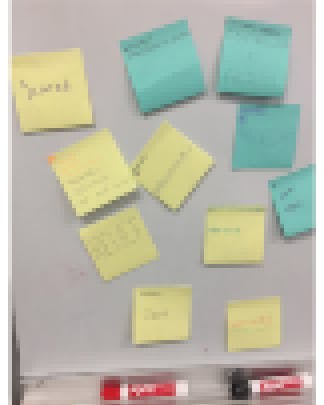Giving regular feedback to roughly 100 middle and high schoolers has been my greatest challenge as an English and writing teacher, and it hit home for me sometime in 2013.
I was describing my 3-year-old’s night terrors to another mom: “So, Vivian is doing this thing where she sits up and screams every night at 2 a.m.” The other mom looked sympathetic.
“Oh, it’s okay,” I assured her. “I just get up and grade papers. It’s my time for catching up.”
She looked at me like I was nuts. And I was. My challenges with the feedback load were officially impacting my health and family life.
By 2015, my daughter’s night terrors had passed, but my problems with feedback remained. Compounding this problem was the fact that I didn’t see much improvement in my students’ work as a result of my efforts. Their cursory skims of the feedback I spent hours on sapped my energy for providing it. Rarely would a student take my feedback and improve her next paper accordingly, even when I required a revision.
My feedback practices were unsustainable, so I began to look for alternatives. Over the next four years, I significantly changed the way I provide feedback. I implemented writing reflections to help students recall their feedback from prior assignments and collaborated with a colleague to develop a teacher guided peer review system, which eventually yielded an app called Floop that made the peer review data visible and simpler to manage.
These changes made a significant impact. Having a snapshot of real-time peer review data gave me more insight into how students were using teacher-developed criteria to evaluate one another. I could see which students needed direct support from me, and I was able to provide more targeted whole-class feedback.
As the feedback burden in my classroom shifted from my shoulders to more of a shared responsibility between my students and I, the load became bearable, and I was able to provide more real-time interventions. Students were getting the feedback they needed faster.
It turned out, however, that faster, more targeted feedback solved only part of the problem. I still had learners who didn’t do much with all the feedback they received. It wasn’t until this past year, when I turned to academic research on feedback literacy—the skills needed to process and make sense of feedback and use it to improve learning—that I found a more holistic solution.
How Research Re-defined the Problem and Offered New Solutions
In 2017, my writing classroom adjoined the science classroom of STEM teacher Christine Witcher, who was interested in the problem I was trying to solve and brought new questions to the table. She pushed me to test and measure the quantitative and qualitative data I was gathering. When my data revealed that some students weren’t productively engaging with the feedback, she nudged me toward academic research. She discovered multiple studies on the efficacy of peer feedback when well-guided by an instructor, some with numerous tips to be mined and applied.
She also found the work of U.K.-based researcher Dr. Naomi Winstone, a cognitive scientist who co-authored an analysis of the existing literature on student processing and implementation of feedback. Winstone and her team identified a number of barriers students may face: an inability to decode feedback, poor knowledge of the strategies for implementing feedback, and, because of various emotional responses, a lack of agency to scrutinize feedback and apply it. Although Winstone’s research focused on findings in higher education, the information was applicable and validating to our work.
I read Dr. Winstone’s review of the existing literature related to feedback and dug into a robust teacher resource that her team designed—the Developing Engagement with Feedback Toolkit (DEFT)—which said, “The barriers to using feedback are as much emotional as they are practical.” This insight officially re-defined the problem for me.
What started as a journey to keep up with the paper stack and to cajole my students into revising their work, had become more about helping students manage, engage with and productively process the different kinds of timely feedback available to them, such as self-assessment, peer review, and generic teacher feedback.
Winstone’s work made me reconsider my solutions too. Rather than offering detailed summative feedback, which comes too late for learning, or focusing on a single intervention, like peer review, I needed to support my students in a broader series of meta-cognitive skill building to support their feedback literacy. I needed to help them seek and understand feedback so they could use it to learn.
The goal is for my students to eventually develop the patience needed to persist through multiple rounds of feedback, to have the motivation to improve even when the process feels stressful and to bring a curiosity about how to learn more deeply, rather than focusing on a letter or number grade.
Unpacking the Emotional Barriers
To better understand the emotional barriers my students faced, I asked them to jot down on a post-it, how they feel when they’re about to receive feedback. The conversation was eye-opening. I realized that I had no idea how my students felt about feedback—I never stopped to ask.

Then we brainstormed ways we could mentally stay in the game during feedback situations, framing our thinking with “if...then...actually” statements.
| “If I’m scared... | ...then I might not even look at my feedback. | Actually... I can look at my feedback in private and wait a day to respond.” |
| “If I’m controlling or prideful... | ...then I might push back on whatever my feedback says because I already know I’m not likely to change. | Actually...I can tell myself that working with the feedback could make my work even better.” |
I stressed how easy it can be for all of us to get stuck in the middle column for too long and miss out on making our work stronger. After that, I kept my eye out for concrete activities and ideas that would help my students understand how to manage their emotions.
I came across researcher Victoria Black’s Ted talk about mentorability and how individuals might improve their ability to respond to feedback. Though her study examined college mentoring programs, there was a clear connection for me. In her research, she found a noteworthy amount of attention paid to coaching mentors, but an absence of training provided to mentees. I saw a similar lack of awareness among my students of the importance of their role as mentees in feedback processes.
What was their responsibility as learners when it came to feedback? How could they take charge? I loved how Black characterized the role of the learner: “The mentee is the driver and the mentor is the co-pilot, helping them get to their destination.”
To put this concept into practice, I had my students role-play in pairs. They sat in classroom chairs, one pretending to be a student driver (the feedback receiver) and the other pretending to be a driver’s ed teacher (the feedback giver). We reviewed Black’s quotation and I asked: “Who’s responsible for the feedback and learning here?”
Several hands went up: “The teacher!”
“No, wait,” others shouted: “The student is driving!”

Then I provided some tricky situations for the student drivers to consider. What if the student driver felt scared in this feedback situation? What if she only felt comfortable when driving too closely to the car in front of her? How should she communicate that to her teacher, the feedback giver? And, what might happen if she didn’t communicate at all?
With a little guidance, the drivers came to the same conclusion that Black did after her research study: that learners must respond to the feedback giver’s advice and offer information about his or her needs.
Ultimately, the cars that role-played successful feedback interactions were just as helpful to our conversation as the ones that didn’t and ended up in the ditch.
Weeks later, as they worked through writing revisions on a writing assignment, having gathered all the fast and readily available feedback they wanted, we referred back to this role-play experience.
It had been almost a year since the sticky-note conversation revealed this group’s feelings about feedback, and their newfound agency spoke volumes. In an exit ticket, students described how they had succeeded in driving their feedback interactions.
One explained that when she didn’t understand the feedback she received, that she asked the person to explain it and tried putting it into her own words. Another explained that she wrote down all of the feedback from her peers and teachers and then edited her revision plan and her draft. A third student said she was successful because she asked her peers to read her draft and left a specific feedback question at the bottom of her story. She added: “That way I can get feedback that I need.”
With teacher-guided peer review, and real-time peer review data, I had solved my greatest teaching problem. Students no longer had to wait to gather quality feedback. And after spending a year leveraging academic research on feedback literacy, I have a stack of strategies for making all forms of feedback not only faster, but more effective.
It turns out that the best way to help students improve their writing is by giving timely, targeted feedback—but it doesn’t necessarily have to come from me and certainly shouldn’t happen at 2 a.m. in my living room. Instead, it should be a team effort forged in the classroom. And when it’s working really well, it’s driven by my students.


